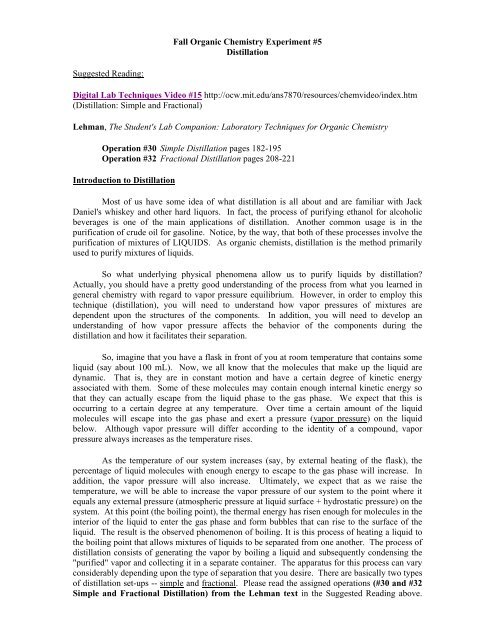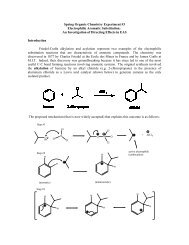Fall Organic Chemistry Experiment #5 Distillation Suggested ...
Fall Organic Chemistry Experiment #5 Distillation Suggested ...
Fall Organic Chemistry Experiment #5 Distillation Suggested ...
You also want an ePaper? Increase the reach of your titles
YUMPU automatically turns print PDFs into web optimized ePapers that Google loves.
<strong>Fall</strong> <strong>Organic</strong> <strong>Chemistry</strong> <strong>Experiment</strong> <strong>#5</strong><strong>Distillation</strong><strong>Suggested</strong> Reading:Digital Lab Techniques Video #15 http://ocw.mit.edu/ans7870/resources/chemvideo/index.htm(<strong>Distillation</strong>: Simple and Fractional)Lehman, The Student's Lab Companion: Laboratory Techniques for <strong>Organic</strong> <strong>Chemistry</strong>Operation #30 Simple <strong>Distillation</strong> pages 182-195Operation #32 Fractional <strong>Distillation</strong> pages 208-221Introduction to <strong>Distillation</strong>Most of us have some idea of what distillation is all about and are familiar with JackDaniel's whiskey and other hard liquors. In fact, the process of purifying ethanol for alcoholicbeverages is one of the main applications of distillation. Another common usage is in thepurification of crude oil for gasoline. Notice, by the way, that both of these processes involve thepurification of mixtures of LIQUIDS. As organic chemists, distillation is the method primarilyused to purify mixtures of liquids.So what underlying physical phenomena allow us to purify liquids by distillation?Actually, you should have a pretty good understanding of the process from what you learned ingeneral chemistry with regard to vapor pressure equilibrium. However, in order to employ thistechnique (distillation), you will need to understand how vapor pressures of mixtures aredependent upon the structures of the components. In addition, you will need to develop anunderstanding of how vapor pressure affects the behavior of the components during thedistillation and how it facilitates their separation.So, imagine that you have a flask in front of you at room temperature that contains someliquid (say about 100 mL). Now, we all know that the molecules that make up the liquid aredynamic. That is, they are in constant motion and have a certain degree of kinetic energyassociated with them. Some of these molecules may contain enough internal kinetic energy sothat they can actually escape from the liquid phase to the gas phase. We expect that this isoccurring to a certain degree at any temperature. Over time a certain amount of the liquidmolecules will escape into the gas phase and exert a pressure (vapor pressure) on the liquidbelow. Although vapor pressure will differ according to the identity of a compound, vaporpressure always increases as the temperature rises.As the temperature of our system increases (say, by external heating of the flask), thepercentage of liquid molecules with enough energy to escape to the gas phase will increase. Inaddition, the vapor pressure will also increase. Ultimately, we expect that as we raise thetemperature, we will be able to increase the vapor pressure of our system to the point where itequals any external pressure (atmospheric pressure at liquid surface + hydrostatic pressure) on thesystem. At this point (the boiling point), the thermal energy has risen enough for molecules in theinterior of the liquid to enter the gas phase and form bubbles that can rise to the surface of theliquid. The result is the observed phenomenon of boiling. It is this process of heating a liquid tothe boiling point that allows mixtures of liquids to be separated from one another. The process ofdistillation consists of generating the vapor by boiling a liquid and subsequently condensing the"purified" vapor and collecting it in a separate container. The apparatus for this process can varyconsiderably depending upon the type of separation that you desire. There are basically two typesof distillation set-ups -- simple and fractional. Please read the assigned operations (#30 and #32Simple and Fractional <strong>Distillation</strong>) from the Lehman text in the <strong>Suggested</strong> Reading above.
These sections will provide you with a comprehensive look at the physical principles andexperimental operations involved in distillation.A note on azeotropesNot all liquids conform to Raoult's law and form ideal solutions. An example is themixture of water and ethanol. Because of certain intermolecular interactions, a unique mixture(an azeotrope) of 95.5% ethanol and 4.5% water forms that boils below (78.1 ˚C) the boilingpoint of ethanol (78.3 ˚C). Thus, we say that ethanol/water mixtures form a low-boiling azeotropebecause the boiling point of the azeotrope is lower than the boiling points of either singlecomponent. No matter how efficient is our distilling apparatus, pure 100% ethanol cannot beobtained by the distillation of a mixture of ethanol/water. You need to be careful when dealingwith azeotropic systems, because a constant boiling point is NOT necessarily an indication of asingle component system. In fact, azeotropes represent an example of a system that consists oftwo (or even three) components that boil at a constant temperature that is different than theboiling point of either pure component.Procedure for <strong>Distillation</strong>The purpose of this experiment is to illustrate the use of distillation to separate a mixture oftwo volatile liquids with different boiling points and to analyze the separation via gaschromatography. Each mixture will be issued to you and consist of a combination of two of thefollowing liquids.Componentscyclohexanetoluenepentaneheptanediethyl ether1-butanolIsobutyl alcohol2-propanolethyl acetate2-butanoneacetone2-butanolThe liquids in the mixture will be separated by FRACTIONAL distillation (See Figure E23 onPage 214 of the Lehman text). The results will be analyzed in a subsequent experiment by gaschromatography-mass spectrometry (GC-MS), infrared (IR) and nuclear magnetic resonance(NMR) spectroscopy. You will also construct a graph of the distillation temperature versus thetotal volume of distillate collected. This graph will enable you to determine the boiling points ofthe two liquids and to evaluate the overall efficiency of the two methods.Each team will acquire an unknown sample mixture of approximately 50 mL. Theappropriate apparatus (MACROSCALE) should be assembled according to the Figure E23 inLehman (page 214). Carefully notice the position of the thermometer bulb in these diagrams. Itmust be positioned correctly for optimum results. Also, note that we will be packing thefractional distillation column with glass beads. Add your unknown mixture to the boiling flaskalong with a stir bar. You’ll heat the flask over a stirrer plate with a heating mantle powered by aVariac.Start circulating the cooling water in the condenser and adjust the heat so that INITIALLYthe liquid boils rapidly. You will want to maintain a gentle boiling as you are heating, so be
advised that you may have to adjust the setting on your Variac. Do not heat up too quicklyotherwise you will not achieve a good separation of components. We want to keep the rate toabout 10 drops of distillate per minute. You are to collect your distillate in a graduated cylinderkeeping track of the volume collected over time. Be sure to record the temperature after every 2-3 mL. At some point during the distillation, you should collect two aliquots in small vials andlabel them “early and late”. YOU NEED TO DETERMINE THE TIMING OF COLLECTIONand you must record the temperature at the moment that you collect these aliquots. Collectapproximately 2 mL of each aliquot. Once you have collected a sufficient amount of your highboiling component, you can cease distillation. DO NOT DISTILL TO DRYNESS. Once yourdistillation is complete, you should save your vials in the refrigerator for subsequent analyses(Exp. #7). Clean up your work area and all glassware. Dispose of your liquids in the appropriatewaste bottles in the fume hood. As usual, keep a good, accurate accounting of the experimentalprocedure and observations in your notebook.
















